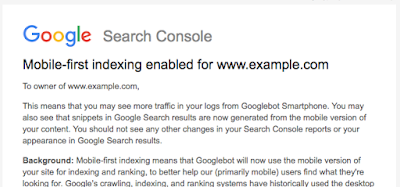Over the years since announcing mobile-first indexing - Google's crawling of the web using a smartphone Googlebot - our analysis has shown that new websites are generally ready for this method of crawling. Accordingly, we're happy to announce that mobile-first indexing will be enabled by default for all new, previously unknown to Google Search, websites starting July 1, 2019. It's fantastic to see that new websites are now generally showing users - and search engines - the same content on both mobile and desktop devices!
You can continue to check for mobile-first indexing of your website by using the URL Inspection Tool in Search Console. By looking at a URL on your website there, you'll quickly see how it was last crawled and indexed. For older websites, we'll continue monitoring and evaluating pages for their readiness for mobile first indexing, and will notify them through Search Console once they're seen as being ready. Since the default state for new websites will be mobile-first indexing, there's no need to send a notification.

Using the URL Inspection Tool to check the mobile-first indexing status
Our guidance on making all websites work well for mobile-first indexing continues to be relevant, for new and existing sites. For existing websites we determine their readiness for mobile-first indexing based on parity of content (including text, images, videos, links), structured data, and other meta-data (for example, titles and descriptions, robots meta tags). We recommend double-checking these factors when a website is launched or significantly redesigned.
While we continue to support responsive web design, dynamic serving, and separate mobile URLs for mobile websites, we recommend responsive web design for new websites. Because of issues and confusion we've seen from separate mobile URLs over the years, both from search engines and users, we recommend using a single URL for both desktop and mobile websites.
Mobile-first indexing has come a long way. We're happy to see how the web has evolved from being focused on desktop, to becoming mobile-friendly, and now to being mostly crawlable and indexable with mobile user-agents! We realize it has taken a lot of work from your side to get there, and on behalf of our mostly-mobile users, we appreciate that. We’ll continue to monitor and evaluate this change carefully. If you have any questions, please drop by our Webmaster forums or our public events.


